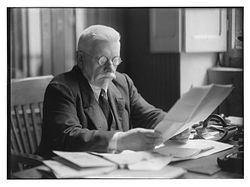Preservation and transmission of the carillon culture
| Preservation and transmission of the carillon culture | |
|---|---|
|
Intangible cultural heritage |
|

|
|
| Carillon player in Bruges |
|
| State (s): |
|
| List: | Register of good practice examples |
| Number: | 01017 |
| Admission: | 2014 |
Preservation and transmission of the carillon culture is a practical example of the preservation of intangible cultural heritage in Belgium listed by UNESCO . It is a program to preserve the musical tradition of playing carillons .
history
The carillon , a playable carillon, has its origin in Belgium , the Netherlands and northern France in the 16th century . It consists of a number of bells of different sizes, which are played by hitting a keyboard with your fist or stepping on pedals. The keyboard or pedals are connected to the clappers of the bells or to hammers arranged outside the bell, which strike the bell when actuated. This requires a lot of strength from the carillonur, the player in a carillon, and is very exhausting.
By the end of the 19th century, the carillon culture declined sharply, and many carillons were decommissioned. Around 1900, the carillonur Jef Denyn (1862–1941) started a program in the Belgian city of Mechelen that was supposed to revive the carillon culture. In 1922 he founded the Royal Carillon School there , which was later named after him. In 1954 the Alumni Association of the Carillon School was founded, which in 1994 was divided into the Vlaamse Beiaard Vereniging and the Association Campanaire Wallonne .
program
The Vlaamse Beiaard Vereniging and the Association Campanaire Wallonne are continuing the program initiated by Jef Denyn to preserve and transmit the carillon culture in order to ensure the continued existence of carillon music as a living heritage. 76 towns and villages in Belgium where the carillon is still or actively practiced take part in the program. The program also receives support from various cultural organizations such as local museums.
However, there is no adherence to traditional schemes, but the versatility of carillon music is also demonstrated. For example, new arrangements and compositions are created or combinations with different music genres are practiced, in which the carilloneur also works with a DJ , for example . The program also promotes new forms of presentation at carillon concerts, such as dance accompaniment . Carillon music is also brought closer to a wider public via new media and social networks . The program also promotes the restoration of carillons, the training of carilloneurs and the exchange between musicians.
The program contributed significantly to the fact that between 1945 and 2014 the number of carillons worldwide rose from fewer than 300 instruments to over 640 and also the number of countries in which there are carillons doubled to 30. One of the other successes of the program is that the number of training centers for carillionurs has increased and that there is now a very lively awareness of the cultural value of the carillon game in Belgium.
Inclusion in the register of good practice examples
The Carillon Culture Preservation and Transmission program was included in the Register of Good Practices in 2014 at the 9th session of the Intergovernmental Committee on the Preservation of Intangible Cultural Heritage .
It was particularly emphasized that the program could serve as a model for other countries to effectively combine activities for dissemination, documentation and public relations. The program shows on the one hand a respect for the tradition of the carillon culture and on the other hand an openness towards innovative developments. The success of the program to increase and spread the carillon culture was also recognized.
Web links
- Carillon - Belgium's intangible cultural heritage on unesco.de, the website of the German Commission for UNESCO
- Preservation and transmission of the Carillon culture on the website of the Intangible Cultural Heritage Section of UNESCO ( English and French ).
Individual evidence
- ↑ Official name English Safeguarding the carillon culture: preservation, transmission, exchange and awareness-raising , French La sauvegarde de la culture du carillon: préservation, transmission, échange et sensibilisation , German name according to the register of good practice examples of the preservation of immaterial cultural heritage. In: www.unesco.de. German UNESCO Commission, accessed on May 1, 2018 .
- ↑ Safeguarding the carillon culture: preservation, transmission, exchange and awareness-raising on the UNESCO website on intangible cultural heritage. In: ich.unesco.org. Intangible Heritage Section of UNESCO, accessed May 1, 2018 .
- ^ Decision of the Intergovernmental Committee: 9.COM 9.B.1. In: ich.unesco.org. Intangible Heritage Section of UNESCO, November 25, 2014, accessed May 2, 2018 .



